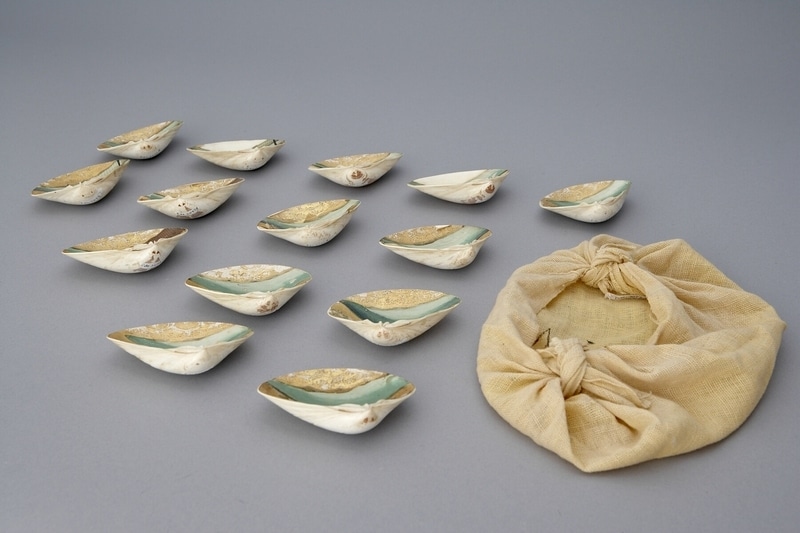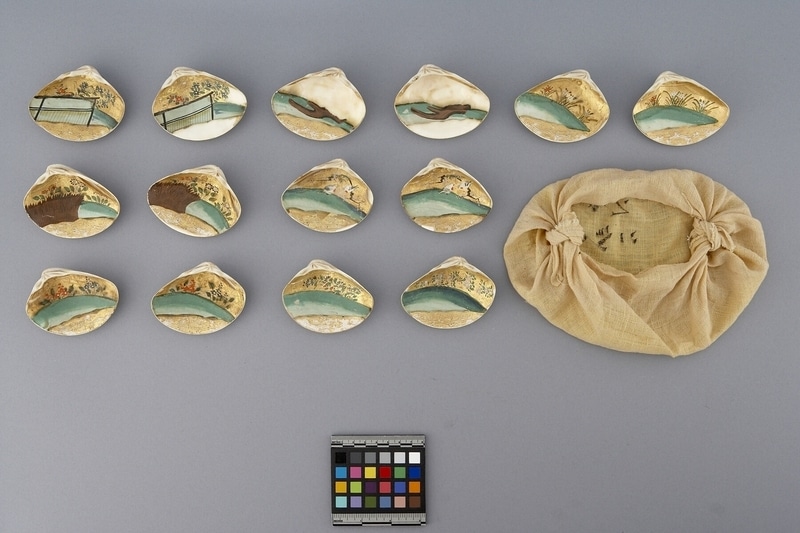Game Item Number: Ed5.3073 a-o from the MOA: University of British Columbia


Description
Part a is a loosely woven yellow cloth, with each pair of corners tied at the sides; used to hold pairs of clam shells for kaiawase (貝合わせ), a shell matching game; the cloth has black calligraphy on the outside. There are seven pairs of cream coloured clam shells (parts b-o), with matching scenes painted on gold paper glued to the insides. The gold paper has dots and geometric patterns; each shell has a horizontal greenish band across it representing a river. The first pair (pts b-c) have red and blue flowers on the upper side. The next pair (pts d-e) have a branch with flowers and two white and black birds with red breasts on the upper half. The third (pts f-g) have brown grass and red and blue flowers in the upper half. The fourth pair (pts h-i) have red and blue flower sprays in the upper half, and the gold is rubbed off in a few places. The fifth pair (pts j-k) have a fence with blue and red flowers above. The sixth (pts l-m) have a brown log-like feature. The last pair (pts n-o) have three white flowers and one red flower in the upper section. Parts b-o have polished, natural shell exteriors.
History Of Use
Kaiawase (貝合わせ), or the game of matching shells, was originally played by court women during the Heian period (794–1185). The game was later played by different classes, and became popular during the Edo period (1603–1868). A complete set of kaiawase contains 360 pairs of shells around the same size. Each pair was decorated with images from literature or nature. The shells are divided into 2 groups; one group, ji-gai (地貝) is scattered on the floor; the other group, dashi-gai (出し貝) are produced by the participants, who compete in finding the correct counterpart on the floor. The winner is decided by obtaining the greatest number of matching pairs.
Item History
- Made in Japan
- Collected between 1927 and 1940
- Owned by Richard Brown
- Owned by Aileen P. Walker and Charles Walker before January 9, 1985
- Received from Aileen P. Walker (Donor) and Charles Walker (Donor) on January 9, 1985
What
- Name
- Game
- Identification Number
- Ed5.3073 a-o
- Type of Item
- game
- Material
- cotton fibre, paper, paint, adhesive and clam shell
- Manufacturing Technique
- polished, glued and painted
- Part A
- height 35.0 cm, width 34.0 cm
- Part B
- height 2.5 cm, width 6.8 cm, depth 8.5 cm
Who
- Culture
- Japanese
- Previous Owner
- Richard Brown, Aileen P. Walker and Charles Walker
- Received from
- Aileen P. Walker (Donor) and Charles Walker (Donor)
Where
- Holding Institution
- MOA: University of British Columbia
- Made in
- Japan
When
- Collection Date
- between 1927 and 1940
- Ownership Date
- before January 9, 1985
- Acquisition Date
- on January 9, 1985
Other
- Condition
- fair
- Accession Number
- 1012/0036 a-o